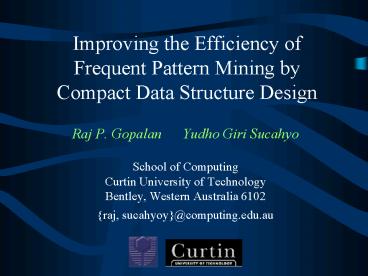Improving the Efficiency of Frequent Pattern Mining by Compact Data Structure Design - PowerPoint PPT Presentation
1 / 22
Title:
Improving the Efficiency of Frequent Pattern Mining by Compact Data Structure Design
Description:
Improving the Efficiency of Frequent Pattern Mining by ... Index 1 2 3 4 5. 1. 2. 2. 1. 1. 1. 1. Item 1 3 4 5 7. Count 3 3 4 3 2. 3 4 5 7. 1 4 5 7. 1 3 4 ... – PowerPoint PPT presentation
Number of Views:103
Avg rating:3.0/5.0
Title: Improving the Efficiency of Frequent Pattern Mining by Compact Data Structure Design
1
Improving the Efficiency of Frequent Pattern
Mining by Compact Data Structure Design
- Raj P. Gopalan Yudho Giri Sucahyo
- School of Computing
- Curtin University of Technology
- Bentley, Western Australia 6102
- raj, sucahyoy_at_computing.edu.au
2
Outline
- Introduction
- Data Structure
- Algorithms
- Performance Study
- Further Work
- Conclusion
3
Introduction
- Association rule mining
- Finds interesting patterns or relationships among
items in a given data set. - Two steps
- Find the frequent itemsets.
- Use the result of Step 1 to generate association
rules. - Step 1 computationally very expensive.
- So, focus of significant research effort.
4
Finding Frequent Itemsets
- Two general approaches
- Candidate generation-and-test
- Apriori (Agrawal et al., SIGMOD93) and its
variants - Pattern Growth Approach
- FP-Growth (Han et al., SIGMOD00)
- H-Mine (Pei et al., ICDM01)
- Opportune Project (OP) (Liu et al., SIGKDD02)
- Data Structures
- Array based H-struct in H-Mine
- Tree based FP-Tree in FP-Growth
5
Contributions
- Present the impact of improving data structure
design on the efficiency of frequent pattern
mining. - Compare the performance with Apriori, Eclat (Zaki
2000), FP-Growth and OP algorithms.
6
Association Rules
- Given a database of transactions containing
various items, statements of the form - A ? B (10, 80)
- 80 of transactions that purchase A also purchase
B and 10 of all transactions contain both of
them.
7
Binary Representations of Transactions
Support 2
8
Data Structures
- Based on these observations
- Item identifiers can be mapped to a range of
integers. - Transaction identifiers can be ignored provided
the items of each transaction are linked together.
9
Transaction Tree
10
ITL Data Structure
- ITEMTABLE
- Every item, with its support and a link to the
first occurrence in TransLink.
- TRANSLINK
- Every transaction in database, with
- items in sorted order.
- Each item has a link to the next
- occurrence.
11
ITL Data Structure
Index 1 2 3 4 5
Item 1 2 3 4 5
Count 2 3 4 4 5
1
1
1
2 3 4 5
2
2
1
1
1
1
1 2 3 5
2
1
1
1 2 4 5
12
Tree Data Structure
- ITEMTABLE
- Every item, with its support and a pointer to
the root of the subtree of the item.
- COMPRESSED TRANSACTION TREE
- All transactions of the database containing
frequent items. Only frequent items will be
stored in the tree.
13
ITL-Mine Algorithm
- Three steps
- Construct ItemTable and TransLink.
- Prune any item below minimum support.
- Mine Frequent Itemsets of 2 or more items.
- Algorithm details in another paper.
14
TreeITL-Mine Algorithm
- Four steps
- Identify Frequent Items and Initialize ItemTable
- Construct Transaction Tree
- Construct ITL
- Mine Frequent Itemsets of 2 or more items.
- Algorithm details in another paper.
15
CT-ITL Algorithm
- Four steps
- Identify Frequent Items and Initialize ItemTable
- Construct the Compressed Transaction Tree
- Construct Compact ITL
- Mine Frequent Item Sets of 2 or more items.
- Algorithm details in another paper.
16
CT-Mine Algorithm
- Three steps
- Identify Frequent Items and Initialize ItemTable
- Construct the Compressed Transaction Tree
- Mining
- Algorithm details in another paper.
17
Performance Study on Connect-4
67,557 trans of items 129 Avg 43 items/trans
18
Performance Study on Pumsb
49,046 trans of items 2,087 Avg 50 items/trans
19
Performance Study on Connect-4
67,557 trans of items 129 Avg 43 items/trans
20
Performance Study on Pumsb
49,046 trans of items 2,087 Avg 50 items/trans
21
Further Work
- Extend CT-ITL and CT-Mine for very large
databases. - Investigate the relative performance of CT-ITL
and CT-Mine on various practical data sets. - Building a Data Mining Query Optimizer.
22
Conclusion
- The influence of compact data structure design on
the performance of frequent pattern mining has
been discussed. - The performance of the algorithms against
Apriori, Eclat, FP-Growth and OP on various data
sets is presented. The results show that our
fastest algorithms perform better than all others
at a number of commonly used support levels.






























